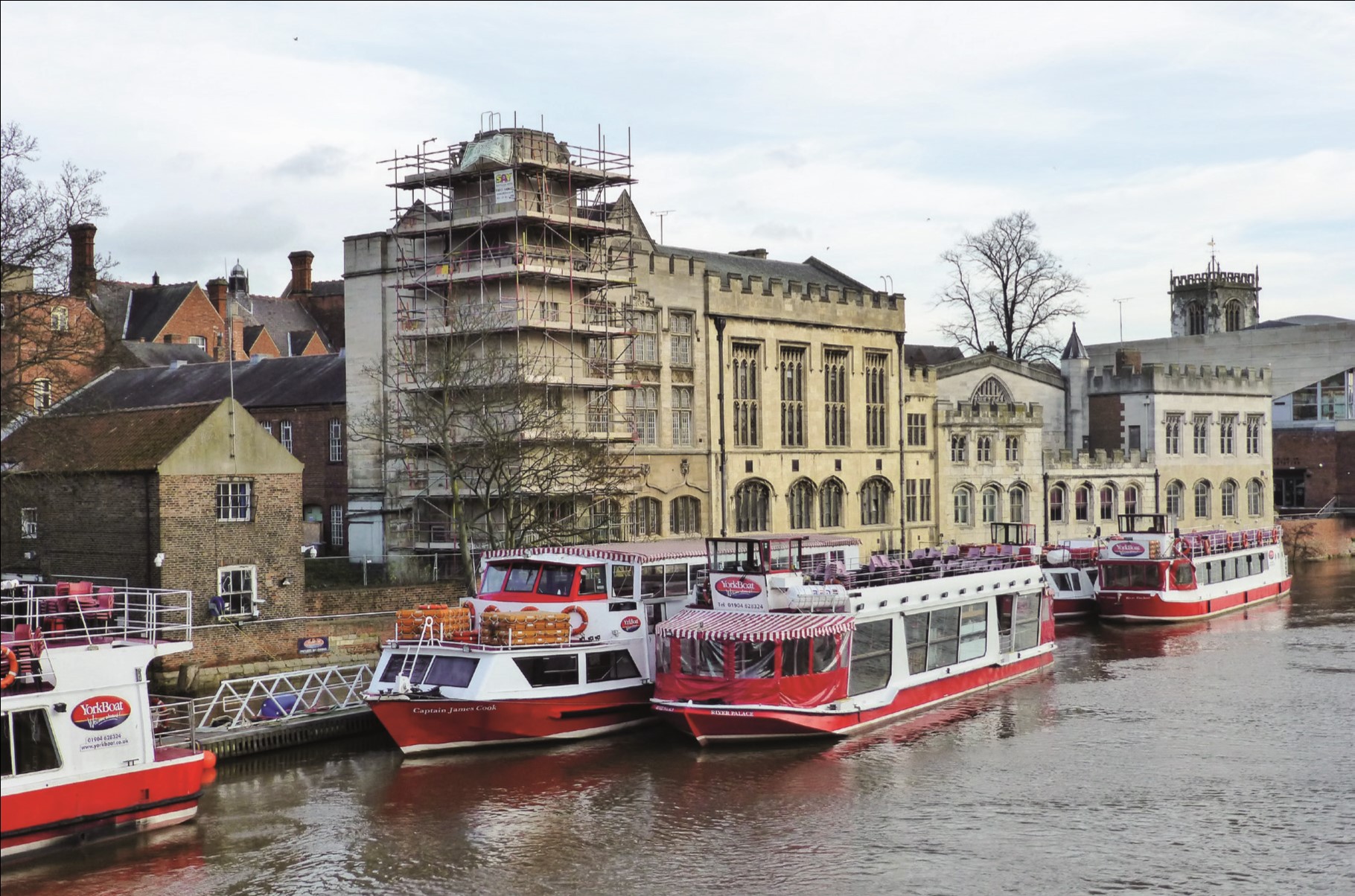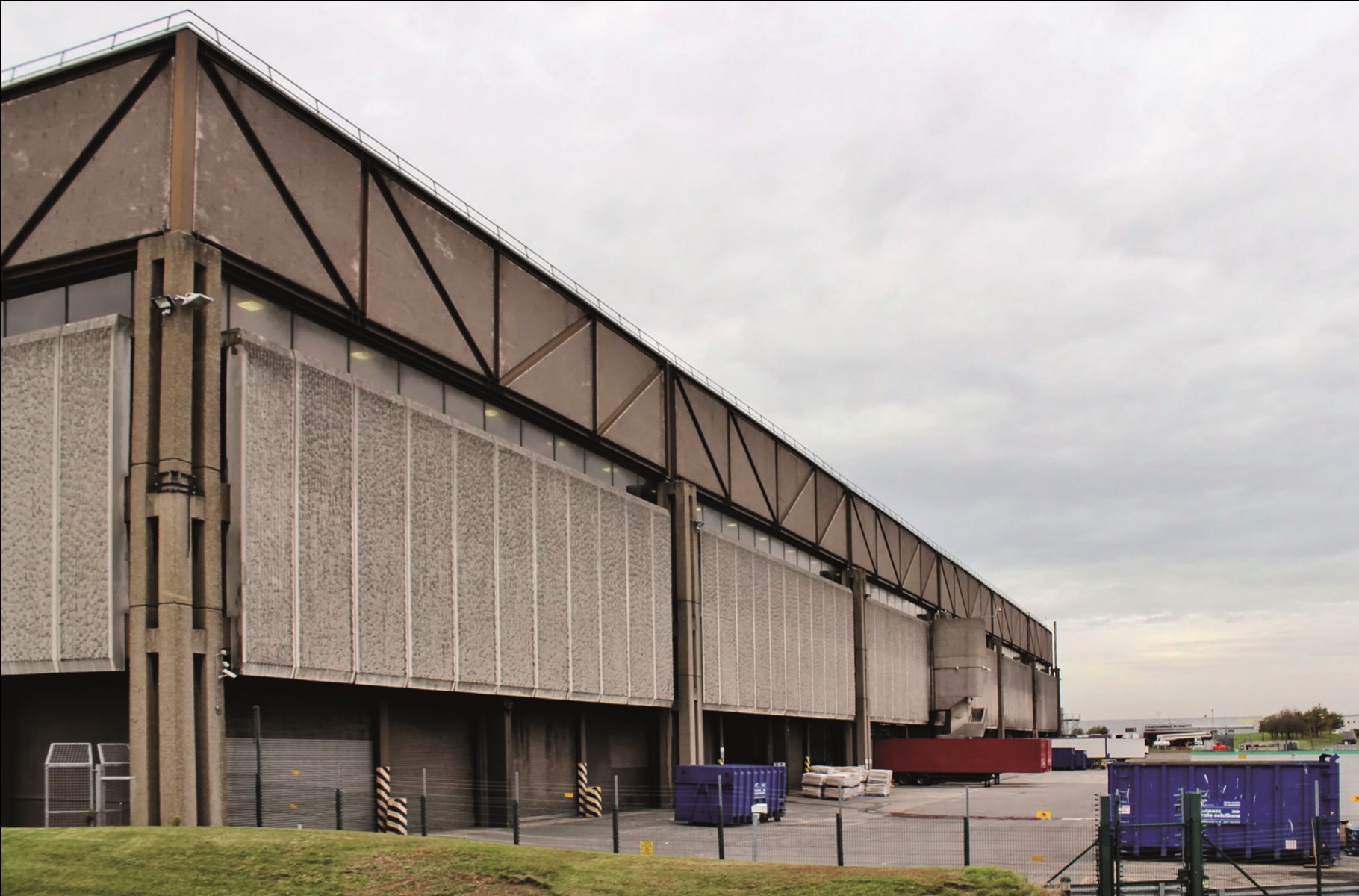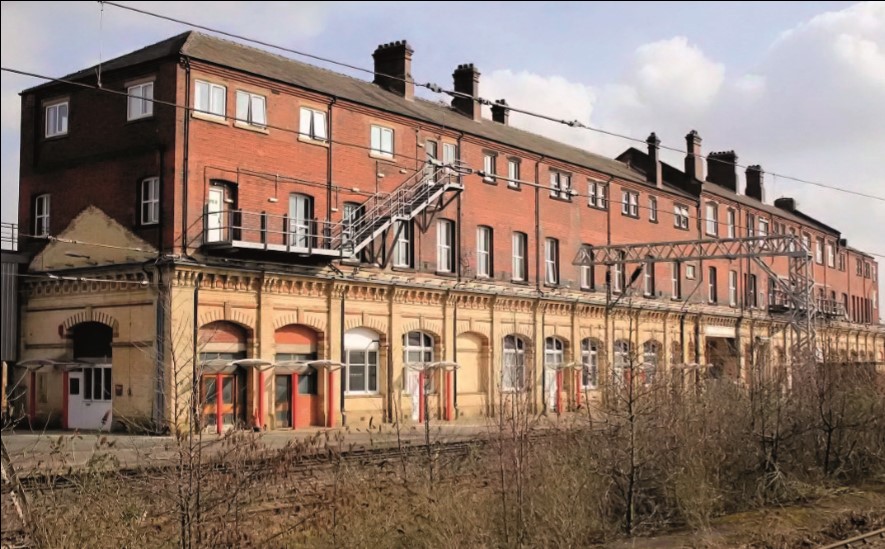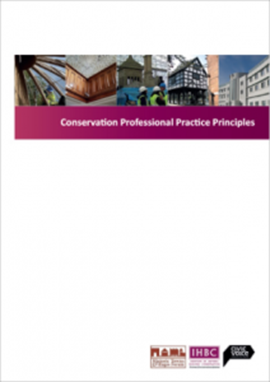Historic England's charged-for services for listing certainty and pre-application planning conversations
This article originally appeared as Charging for certainty, in Context 146 published in September 2016 by The Institute of Historic Building Conservation. It was written by Emily Gee.
Historic England is offering a series of charged-for services that give owners more opportunities to pursue listing certainty and pre-application planning conversations.
[Image: A complex series of listings in York comprises the 15th-century Guildhall and 18th-century Mansion House, both listed at Grade I in 1954, and the late 19th-century Grade II Municipal Offices. Copyright Historic England.]
Last October, Historic England, then still quite a new body, launched a new way of working to respond to modern times. Following through our commitment to government to seek new funding revenues, prioritise our work and continue to respond to the growth agenda, Historic England launched a series of charged-for services that give owners more opportunities to pursue listing certainty and pre-application planning conversations. This work is not profit-making and is done on a cost-recovery basis only, but it allows Historic England to get involved in important listing work that we could not otherwise prioritise.
Three of the services relate to listing: listing enhancement (revising an older list entry); fast-track listing (providing advice to the Department for Culture, Media and Sport (DCMS) to an agreed deadline, including for certificates of immunity cases), listing screening (a research and listing survey of an area to provide historical overview and an indication of where listing assessment should be considered); and the fourth is extended pre-application advice, providing pre-application planning advice beyond an initial free service. The average case costs about £2,800. Feedback suggests that this is a reasonable price for the clarity and certainty that it brings – or ‘de-risking’, as one customer put it.
Nearly a year in (nine months at the time of writing), it is a good time to update IHBC colleagues on how we, and the sector, have adapted to the new way of working. One of our promises to Treasury, and to the people, is to maintain the free service – that is, the consideration of listing applications for sites that are under threat, with strong claims to evident significance, or forming part of a current project (such as on post-war schools). These types of applications will be taken forward by our busy listing teams just as before. But sometimes owners and their agents want certainty that we can not justify taking forward under these guidelines that help us prioritise our limited resources. It is these areas where the new services can be useful: for example, from owners of large estates to individual houses, planning and heritage consultants and local planning authorities. Here is a flavour of the kind of work we have done so far in listing under enhanced advisory services (EAS).
We have handled 23 certificate of immunity from listing (COI) application requests under the Fast Track Listing service and, at the time of writing (July 2016) have completed 13 cases to an agreed, fast-tracked deadline. Historically, recommendations to the DCMS on COIs have generally taken six months to complete, but under EAS our advice is sent to DCMS in half the time, usually to an agreed deadline of around 10-18 weeks, depending on the circumstances. While we can only agree Historic England timescales, the DCMS decides most of all case types quite quickly.
The Historic England advice remains the same, of course, but the service means that owners will generally have an answer much sooner than before. And when certainty is required, such as in advance of purchasing a site or submitting a planning application, that is seen as a real benefit of the new offer. As before, sometimes a COI application will result in listing, when special interest is present. We remind owners that it is about providing certainty rather than necessarily an automatic refusal to list. One COI case under EAS has resulted in listing, but any new listing will always make it clear where the special interest lies, and where it doesn’t.
We were asked to assess the Horizon Tobacco Factory in Nottingham, 1969–71 by Peter Foggo of Arup Associates, for a COI. The buildings fall within the Nottingham enterprise zone. While we had previously assessed and recommended not to list, with which the DCMS agreed, the owners sought the absolute certainty of a COI, which is valid for five years. The Tobacco Factory is an interesting building with some claims to innovation, but where notable features had been removed. The high threshold for listing post-war architecture meant that it did not meet the test and a COI was issued.
[Image: The Horizon Tobacco Factory in Nottingham, 1969–71, by Peter Foggo of Arup Associates. Copyright Historic England.]
We also carefully considered five buildings of the 1960s and 1970s on the Calthorpe Estate in Birmingham, and recommended COIs in each case. As part of this package of Calthorpe work we also revised the list entries for three listed groups of buildings: an 1830s house and stable block, a pair of early 19th-century houses, and a Regency terrace, which extraordinarily had been rebuilt behind the facade in the 1970s, an intervention that did not diminish the interest of the characterful frontage, but which deserved to be legally excluded from the new list entry.
We have been struck by how varied the scale of EAS applications has been. This gives an indication of how the new service is helpful to a wide range of customers: from individual home-owners to managers of major developments and infrastructure. Our consultation with the sector indicated that owners of houses listed some decades ago might desire an updated list entry for their house to help inform listed building consent applications. These listing enhancements can be a very cost effective way of understanding the building better and helping to inform the management of change.
A list entry from the 1970s or 1980s will inevitably be shorter and less precise than a modern one, and the kind of clarity that listing provides as a matter of course with new ones can be helpful. Enhanced listings do not just add length, they add clarity about where special interest lies (and where it doesn’t, including within the curtilage). That can be a helpful starting point for discussions about significance and managing change. We have seen a few of these kinds of applications and anticipate more.
This kind of clarity can be especially important at major sites in public or private ownership where master planning or development is proposed. Historic England has reassessed a few of these under our new services already. Perhaps the most noteworthy – for its extraordinary Alfred Waterhouse terracotta design, not to mention the rather remarkable skeletal contents – has been the Natural History Museum in the Royal Borough of Kensington and Chelsea. First listed at Grade I in 1969 – nearly 50 years ago – the list entry for this much-loved museum was only nine lines long. Such brevity, not uncommon for earlier listings, shows that early list entries were intended primarily for identification; but it was hardly sufficient for a vast complex with multiple phasing and functions, and a complex management regime and vision for the future.
Responding to an EAS application, we comprehensively updated the 1969 list entry following a full inspection and wide-ranging consultation. As part of this we excluded the deferential modern Palaeontology Wing, while reinforcing that Allison and Markham’s Earth Galleries (1929–33) and the bespoke Whale Hall (1929–31) had special interest and were included. Perhaps unsurprisingly, the new list entry is nearly 50 times as long as the original one. It is worth reminding that a list entry is never intended to be the last word on a site: conservation management plans, reports and publications will all continue to serve important roles. But where further clarity is required to inform conversations about significance, an enhanced list entry can contribute helpfully to the process of understanding and change.
[Image: The whale hall at the Natural History Museum. Copyright Historic England.]
The other major building that has been updated under EAS is a complex series of listings in York, comprising the 15th-century Guildhall and 18th-century Mansion House, both listed at Grade I in 1954, and the late 19th-century Grade II Municipal Offices. The EAS application was to amend the list entries and to determine the status of curtilage buildings. The City of York Council is presently engaged in pre-planning discussions for the site which need to be based on a sound assessment of significance. Historic England carefully reassessed this important civic complex, deploying best practice such as powers of exclusion, to say where special interest is manifestly present, and where it is lacking. We modernised each of the list entries, upgraded the Municipal Offices to Grade II*, and listed the former muniment room and cells at Grade II. Such revisions may well result in different parts of a site being differently graded to reflect significance.
We have also handled a few listing screening cases. This new service involves Historic England’s research teams preparing a report of a site’s historical and architectural development, in part to guide an informal recommendation about which assets might warrant assessment for listing and which would not. The hoped-for next step would be a request for a fast-track assessment of any possible listing candidates so that all parties have certainty. We have completed two of these: for a site at a university and another screening for Network Rail’s Crewe Station. In one case we were able to confirm that none of the buildings in the study area would warrant listing; in the second we identified that a discrete group of railway structures from the 1860s would benefit from a full listing assessment. Network Rail, the owner, has pursued this, so it is a live listing case as I write. A service level agreement for continuing work of this nature might be an appropriate way forward for some major estate owners as well.
[Image: Platform 12 at Crewe Station (1903–6). Copyright Historic England.]
This is a new way of working for us at Historic England, a delicate but achievable balance of new customer relationships while maintaining the free service. Our advice remains the same but through EAS we are pleased to be able to take on work that owners and managers of heritage sites need. This work is broadly happening across the country, with an inevitable concentration in London and the south east, and has already covered a wide range of sites, from individual houses to large public estates. The common factor is a need for clarity and certainty, which we are committed to providing, since that is good for all parties as well as the historic environment.
Emily Gee is head of listing advice at Historic England.
--Institute of Historic Building Conservation
Find out more
Related articles on Designing Buildings Wiki
- Charging for Listed Building Consent pre-application advice.
- Conservation.
- Heritage Action Zone.
- Historic England.
- IHBC articles on Designing Buildings Wiki.
- Institute of Historic Building Conservation.
- Listed buildings.
- Planning authority duty to provide specialist conservation advice.
- Planning permission.
- Pre-application advice for planning permission.
IHBC NewsBlog
Heritage Building Retrofit Toolkit developed by City of London and Purcell
The toolkit is designed to provide clear and actionable guidance for owners, occupiers and caretakers of historic and listed buildings.
70 countries sign Declaration de Chaillot at Buildings & Climate Global Forum
The declaration is a foundational document enabling progress towards a ‘rapid, fair, and effective transition of the buildings sector’
Bookings open for IHBC Annual School 12-15 June 2024
Theme: Place and Building Care - Finance, Policy and People in Conservation Practice
Rare Sliding Canal Bridge in the UK gets a Major Update
A moveable rail bridge over the Stainforth and Keadby Canal in the Midlands in England has been completely overhauled.
'Restoration and Renewal: Developing the strategic case' Published
The House of Commons Library has published the research briefing, outlining the different options for the Palace of Westminster.
Brum’s Broad Street skyscraper plans approved with unusual rule for residents
A report by a council officer says that the development would provide for a mix of accommodation in a ‘high quality, secure environment...
English Housing Survey 2022 to 2023
Initial findings from the English Housing Survey 2022 to 2023 have been published.
Audit Wales research report: Sustainable development?
A new report from Audit Wales examines how Welsh Councils are supporting repurposing and regeneration of vacant properties and brownfield sites.
New Guidance Launched on ‘Understanding Special Historic Interest in Listing’
Historic England (HE) has published this guidance to help people better understand special historic interest, one of the two main criteria used to decide whether a building can be listed or not.
"Conservation Professional Practice Principles" to be updated by IHBC, HTVF, CV
IHBC, HTVF, and CV look to renew this cross-sector statement on practice principles for specialists working in built and historic environment conservation roles.





















